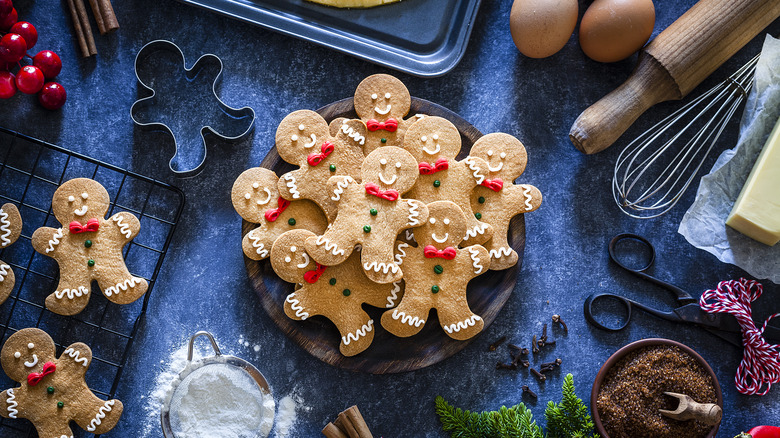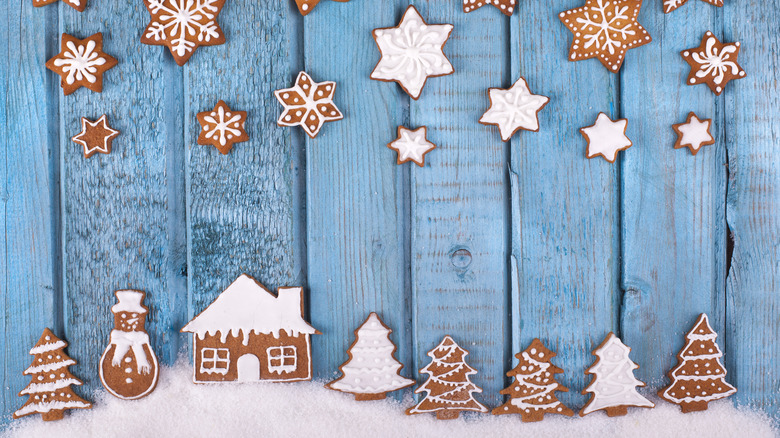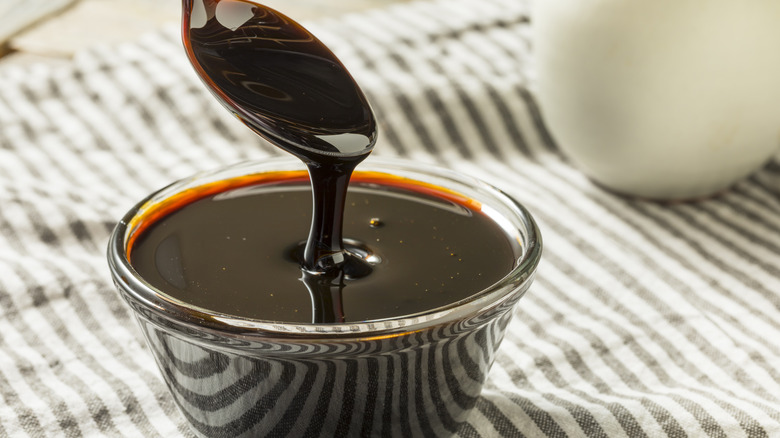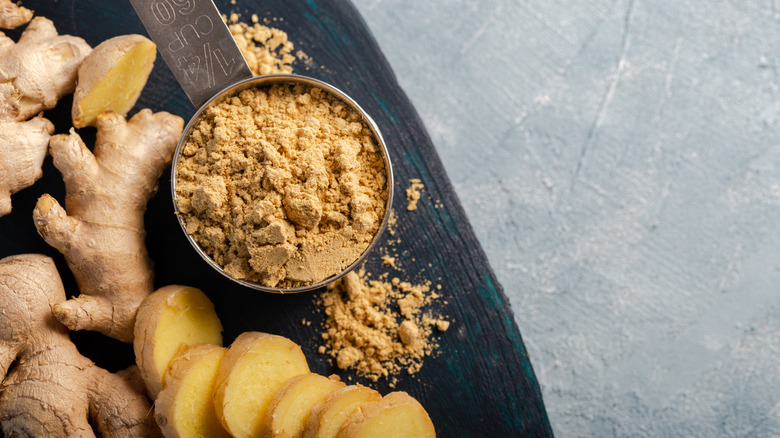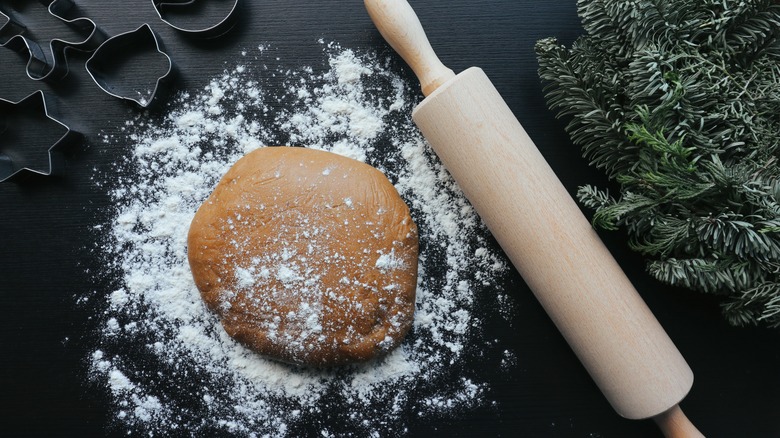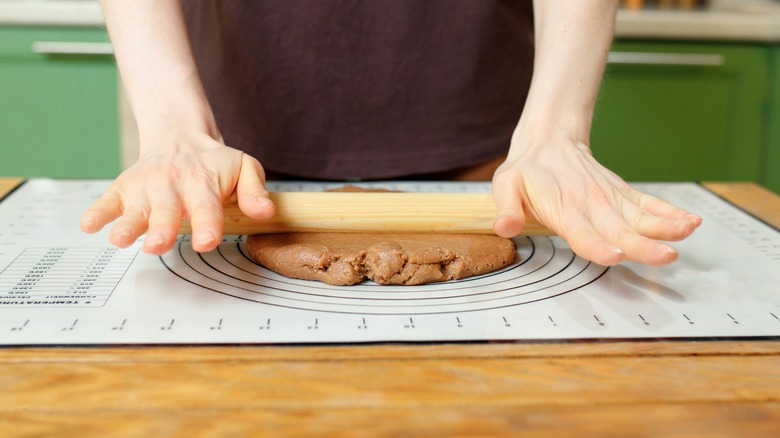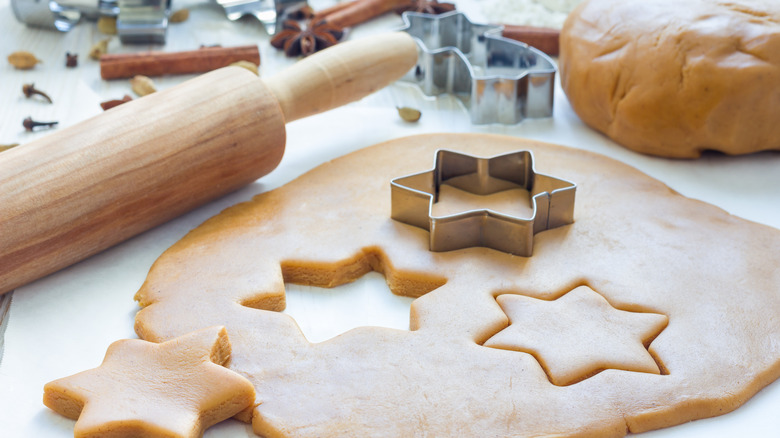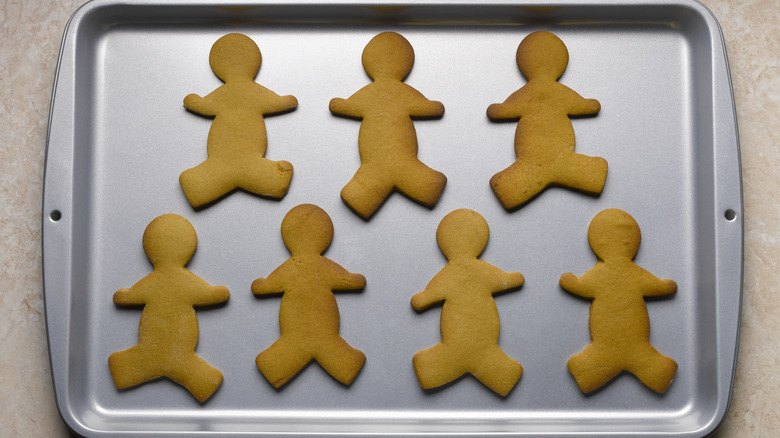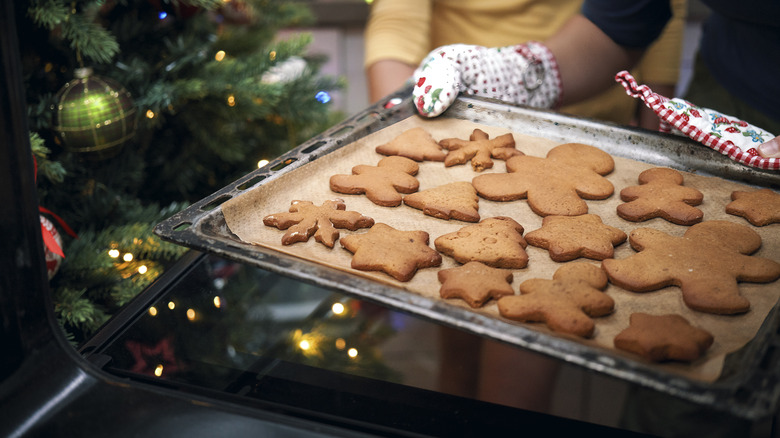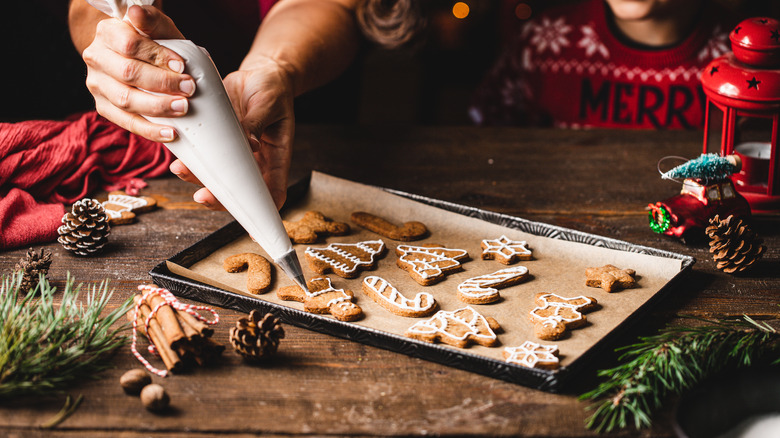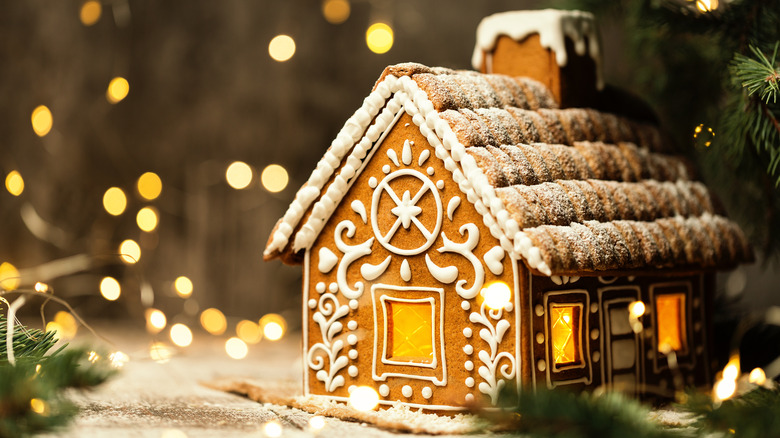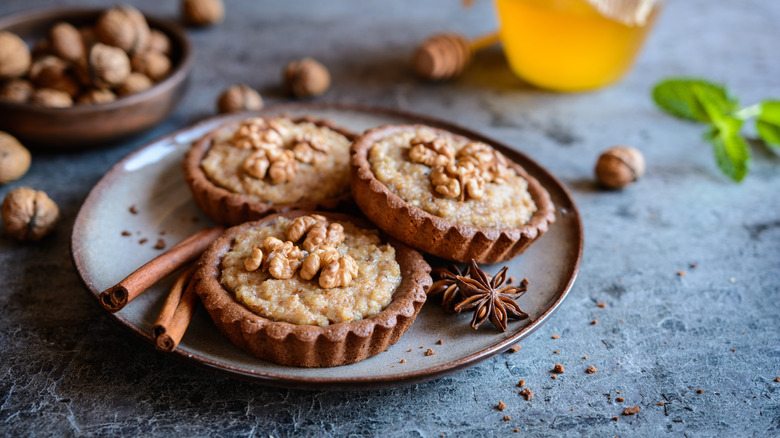12 Of The Biggest Mistakes Everyone Makes With Gingerbread
When it's time to start getting into the holiday spirit, there is one food that symbolizes the festive season: gingerbread. From gingerbread houses to gingerbread men, ginger snaps, and all kinds of gingerbread-based desserts, the iconic smell of ginger and spices signals it is time to be merry and start baking holiday favorites for friends and family.
Historically, gingerbread was only for the elite and not related to the holiday. The original recipe was different than today's version, with breadcrumbs instead of flour, aniseeds for spice, and red wine for flavor. The early recipe was called Elizabethian gingerbread and was popular among royalty in the 17th century. We have Queen Elizabeth I to thank for the creation of gingerbread men, which were designed and decorated with gold leaf. Later, gingerbread became more accessible to the masses, and it was sweetened with honey and molasses. Eventually, it became synonymous with Christmas time and the holiday spirit.
You have probably decorated gingerbread cookies and maybe even constructed a gingerbread house from one of those holiday kits. But making gingerbread from scratch can be challenging. Getting the right mix of ginger, molasses, cinnamon, cloves, and allspice takes some practice. And getting the dough just right is a skill that takes some time to master. If you are looking to fine-tune your gingerbread skills, there are several big mistakes to avoid, which we've gathered from the advice of baking experts so that you can bake gingerbread for any occasion.
Starting without a plan
Before you pull out that big bag of flour and tie your apron on, you need to have a baking plan. Gingerbread recipes vary depending on what you are planning to make. For gingerbread men, the recipe is different than if you are making the walls for a gingerbread house. Gingerbread cookies should be soft and chewy or, in the case of ginger snaps, have a slight crunch, but those recipes will be too soft to use for the parts of a gingerbread house.
Gingerbread for gingerbread houses doesn't have as much butter or molasses as cookie recipes. But the main difference in the recipes for gingerbread cookies versus gingerbread houses is the leavening agent baking soda. Baking soda is responsible for the dough spreading during the baking process. A little spread for cookies is fine and gives the cookie a softer texture. But for gingerbread houses, you will need to keep the baking soda in the pantry and out of your mixing bowl so the gingerbread house walls and roof pieces don't spread, making them an odd shape and too soft for proper building. If you find yourself in this situation and the building pieces are too spread, try using a knife or pizza cutter to cut the sides and leave them uncovered to harden up as they get stale. Within a day or two, they should be ready for building.
Missing the mark with molasses
Gingerbread gets its dark color from thick, sticky molasses, which is a by-product of the sugar cane refining process. It is mildly sweet and can be light or darker in color. Molasses mixed with white sugar create brown sugar. Both molasses and brown sugar are used in desserts, including gingerbread. The thick dark syrup with the unique taste adds more than just a sweetness. It also has a slightly smoky undertone. When you scan the supermarket shelves for molasses, you will find three types: light, dark, and blackstrap molasses.
Light molasses is lighter in color and taste. It is sweeter than dark molasses and resembles honey or maple syrup. You could use it to sweeten tea or drizzle on toast. While dark molasses is thicker with a more muted sweetness, this is the one you want to choose for making gingerbread. Dark molasses isn't just for desserts. It's also used in barbecue sauces, marinades, and glazes. It pairs well with rich, fatty meats.
Blackstrap molasses is the darkest of the molasses and the least sweet. It has some medicinal benefits, according to Healthline, which is one reason you may find it more readily available in health food stores rather than in the supermarket. Blackstrap molasses is more commonly used in savory glazes and marinades and isn't ideal for desserts because of the slightly bitter taste. So save it for your favorite savory sauces, and use dark molasses for your gingerbread.
Using the wrong form of ginger
Gingerbread desserts have a distinct flavor, and using the wrong type of ginger can affect the taste and make it too strong or too mild. Some gingerbread recipes call for fresh ginger, and others use powdered ground ginger. The two are not interchangeable. If your recipe calls for one and you need to substitute 1 teaspoon of fresh minced ginger, it's the equivalent of just ¼ a teaspoon of ground.
If you are making gingerbread for decorative purposes like a house or Christmas tree ornaments, then ground ginger is best because it will give off that nice, strong aroma. Just make sure to smell your jar of ground ginger to make sure it still has a distinct scent. Since it is one of those spices that probably doesn't get used as often as others in your cabinet, it can get old, and the scent can fade.
Some gingerbread recipes call for candied ginger, which is ginger pieces that have been boiled and covered in sugar. You can find it in most supermarkets, but making your own is just as easy. Candied ginger is chopped and added to gingerbread cookies and cakes, adding texture and a sweet, slightly spicy surprise to every bite.
Not letting the dough chill
It is easy to get busy in the kitchen and want to look for shortcuts or hacks to recipes. In the case of gingerbread, you can not skip the one crucial step of chilling the dough. After mixing all the ingredients, the dough needs anywhere from an hour to overnight to chill.
The dough benefits from the chilling time to keep it from spreading and ruining your cute shapes. The best way to chill the dough is to form it into two disks, like two thick frisbees, and cover it with plastic wrap. Of course, you can just leave it in a ball in the bowl, but the disks make rolling the dough out easier.
Once you roll it out and cut your shapes, lay them on a baking sheet and put them back in the refrigerator before baking them. The dough will benefit from another quick chill since it warms up during the rolling out and cutting process.
If you are behind schedule, you can also chill the dough in the freezer. It's not ideal, but you put it in the freezer for about a quarter of the time. The dough will be more challenging to roll out, but the short freezer stay can help keep it from the dreaded spread.
Rolling the dough too thick or thin
Another common mistake everyone makes with gingerbread is not rolling out the dough with a consistent thickness. If the dough is rolled out too thick, it won't bake evenly or will have to bake for too long, making the sugar and molasses-filled cookies too hard. While rolling the dough out too thin leads to cracking and crumbling. Ideally, you should roll your gingerbread dough out to between and ⅛ to ¼ of an inch.
If you bake a lot, you might to consider getting an adjustable rolling pin that measures thickness to get it just right. But a basic rolling pin works, too. If you don't have a rolling pin, use a similar-shaped bottle, like a wine or water bottle, to roll out the dough. One little trick to keep the shapes smooth, whether for gingerbread cookies or houses, is to lay a plastic wrap over the dough as you roll to avoid wrinkling the dough.
Using the wrong cookie cutters
Cookie cutters come in cute shapes and different sizes. Some are made from plastic or silicone, but the ones you need for making gingerbread cut-out cookies are the stainless steel ones. Plastic cookie cutters are cheap and readily available, but they won't give a clean cut like stainless steel ones. Plastic cookie cutters actually smush the dough and flatten it rather than cut it, especially with tougher dough like gingerbread dough.
Those clean-cut lines you get from stainless steel cutters are important to help the cookies keep their shape and the dough from tearing. Yes, stainless steel cookie cutters are more expensive, but look at them like an investment in your family holiday traditions because you can use them for many holiday seasons.
If you don't want to invest in stainless steel cookie cutters, you can make round cookies using the metal ring from a canning jar as a cutter. The metal will cut through the dough easily. And if you can't find a canning lid ring, just use an upturned water glass. Just use plenty of flour to keep the dough from sticking to the glass.
Overcrowding the baking sheet
This is just a general rule of cooking: Don't overcrowd the frying pan, and the rule applies to baking, too. Whether making cookies or roasting vegetables, overcrowding the pan will affect the texture and cooking time. In the case of cookie overcrowding, the pan will lead to a flatter cookie due to too many cookies using the same heat source. If you bake a lot, invest in another baking sheet or two, giving you plenty of room for holiday cookies.
If you are not overcrowding the baking sheet and your gingerbread cookies are still coming out too flat, the problem may be with how you are lining your baking sheet. A silicon baking mat is the best way to line a baking sheet for minimal spread. If you actually like a little bit of spread on your cookies for a crispier edge and chew the middle, then bake the cookies on a greased baking sheet. You can also bake them directly on the baking sheet; the only possible downside is some cookies may stick to the pan and break when moving them.
Baking at the wrong temperature
Just like sugar cookies and brownies, gingerbread cookies can burn quickly, and it is better to take them about before it is too late. The sugar and molasses will turn rock hard, and instead of a tasty, chewy bite, you will get a jaw workout trying to chew overly baked gingerbread cookies. Luckily, a simple way to prevent this is to use the low and slow method and set your oven to 325 degrees Fahrenheit. Baking will take a little longer, but you can better control the temperature and keep them from burning. Some bakers suggest using parchment paper as a lining to help keep the cookies from burning.
Once the cookies are done baking, let them rest for a few minutes before transferring them to a cooling rack. If you try removing them immediately after coming out of the oven, they will still be a little too soft and break apart, which is fine if a broken one means you get an early taste test. But for the rest of the cookies, let them set for three minutes. This is why it's ideal to have a couple of baking sheets so that while the cookies are cooling on one, you can have another ready to go in the oven.
Trying to decorate when the cookies are still warm
It's easy to get lost in the holiday excitement of baking seasonal treats when the house smells like ginger and spice. But patience is key when it comes to decorating cookies with icing. If you try to ice cookies when they are too warm, the icing will slide right off. Handling a warm cookie means it will most likely crumble in your hands before the icing even touches the cookie. Experts recommend waiting at least eight hours.
Once your cookies have cooled, you can get your icing ready and let your creative juices flow. One easy hack to creating designs on gingerbread cookies is to use the cookie cutter as an outline to help you get clean lines. It's best to ice the outline of the cookie and then either fill in the rest or make a design. Those who like a more elegant design but lack the artistic skills to get there should consider baking stencils. They can help you make intricate patterns like snowflake designs.
Not using Royal icing to decorate cookies
There are a couple of options for cookie icing, buttercream frosting and royal icing. Buttercream frosting is common for frosting cupcakes and decorating cakes, but it is not the best choice for decorating cookies. Royal icing is the better choice because it is thinner in consistency and easier to manipulate so that you can decorate your gingerbread men, snowflakes, Christmas trees, and other cookie shapes.
Royal icing is made with powdered sugar, cream of tartar, egg whites, and vanilla. It is easy to whip together and then add in the food coloring. One tip when working with royal icing is to work fast and cover any icing you aren't using because it dries quickly. And if you find yourself ready to make royal icing but realize you don't have any powdered sugar, there is a simple fix: Throw 1 cup of regular granulated table sugar in the blender with 1 tablespoon of cornstarch.
Using icing to hold the gingerbread house together
While royal icing on gingerbread cookies is an excellent way to decorate, it is not ideal for constructing a gingerbread house. Gingerbread houses need stronger icing to hold the pieces together, especially if you like to get elaborate with your gingerbread houses and make something more complicated like a gingerbread mansion; think Tudor style or a Queen Anne-inspired house. Whatever design you decide to go with, you will need a solid structure, and cookie icing isn't ideal.
Instead, take the advice of an expert gingerbread housemaker, Erica Kahn, from the Brown University of Engineering. As per her recommendation on NPR, "Melting down caramel, gummy candies, and marshmallows" will keep the gingerbread house edible but give it the structural integrity to stay together so you can build a better gingerbread house that won't topple over. So dig through that old Halloween candy and see if you have any left to make this edible epoxy-like substance. Then, let your imagination go wild and build an amazing gingerbread house.
Not trying other creative ways to use gingerbread
Gingerbread is not just for cookies and houses; that unique spicy taste is excellent in other recipes, too. Try gingerbread cheesecake, bread, fudge, and pumpkin pie. Turn crushed gingerbread cookies into a pie crust. Or mix crushed cookies with oatmeal for a fruit crisp or crumble. Treat your family to gingerbread waffles or pancakes during the Christmas holiday. You will love the festive aroma that will fill the house.
Gingerbread isn't just for sweets; you can also use it for savory dishes — crushed cookies on meat-filled casseroles. Or slice up loaves of gingerbread and toast with other spices for slightly sweet, slightly savory croutons, perfect for topping roasted squash soup or holiday salad. Take a page from French cuisine and use crushed gingerbread as a breading for poultry or vegetable fritters. Or try the Polish Christmas tradition of making a gingerbread sauce poured on fish topped with raisins and almonds. Or start your own holiday tradition and use gingerbread in your festive savory dish.
